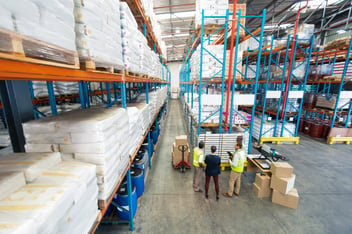Discover how innovative 3PL warehouse solutions can enhance performance and streamline operations.
The Evolution of 3PL Warehousing
The evolution of 3PL warehousing has been driven by the need for efficient and cost-effective logistics solutions. In the past, companies used to handle their own warehousing operations, but with the increasing complexity of supply chains and the rising demand for faster deliveries, the need for third-party logistics (3PL) providers emerged. These providers specialize in warehousing and transportation, offering companies the opportunity to outsource these functions and focus on their core competencies.
Over time, 3PL warehousing has evolved to meet the changing needs of businesses. Initially, it involved basic storage and distribution services. However, with advancements in technology and the growing demand for more sophisticated logistics solutions, 3PL providers have expanded their offerings. They now offer value-added services such as inventory management, order fulfillment, and even customized packaging and labeling.
The evolution of 3PL warehousing has also been influenced by the rise of e-commerce and omnichannel retailing. With the increasing popularity of online shopping, companies need efficient and flexible warehousing solutions to handle the growing volume of orders and ensure timely deliveries. 3PL providers have responded to this demand by investing in advanced technologies and optimizing their operations to meet the unique requirements of e-commerce fulfillment.
Overall, the evolution of 3PL warehousing has been driven by the need for efficient, flexible, and cost-effective logistics solutions. As businesses continue to face new challenges and opportunities, 3PL providers will play a crucial role in helping them navigate the complex world of supply chain management.
Key Benefits of Innovative 3PL Warehouse Solutions
Innovative 3PL warehouse solutions offer a range of key benefits for businesses. One of the main advantages is improved efficiency. By outsourcing warehousing and logistics functions to a specialized provider, companies can benefit from their expertise and experience. 3PL providers have the knowledge and resources to optimize warehouse operations, streamline processes, and reduce costs. They can also leverage their network of distribution centers to provide faster and more reliable deliveries.
Another benefit of innovative 3PL warehouse solutions is scalability. As businesses grow and their logistics needs change, 3PL providers can easily scale their operations to accommodate the increased demand. They have the flexibility to adapt to fluctuating order volumes and seasonal peaks, ensuring that companies can meet customer demands without investing in additional infrastructure or resources.
Cost savings are also a significant advantage of innovative 3PL warehouse solutions. By outsourcing warehousing and logistics functions, companies can avoid the upfront costs associated with building or leasing their own facilities. They can also benefit from economies of scale, as 3PL providers can negotiate better rates with carriers and suppliers due to their larger volumes. Additionally, outsourcing allows companies to focus their resources on their core competencies, such as product development and marketing, leading to improved overall performance.
Lastly, innovative 3PL warehouse solutions provide access to advanced technologies and systems. 3PL providers invest in state-of-the-art warehouse management systems, automation technologies, and data analytics tools to optimize operations and improve visibility. These technologies enable real-time tracking of inventory, accurate demand forecasting, and efficient order fulfillment, resulting in improved customer satisfaction and loyalty.
In conclusion, innovative 3PL warehouse solutions offer improved efficiency, scalability, cost savings, and access to advanced technologies. By partnering with a reliable 3PL provider, businesses can enhance their supply chain operations and gain a competitive edge in today's fast-paced business environment.
Advanced Technologies Transforming Warehouse Operations
Advanced technologies are revolutionizing warehouse operations, enabling 3PL providers to offer more efficient and accurate services. One of the key technologies transforming the industry is automation. Automated systems such as robotic picking and packing, conveyor belts, and automated guided vehicles (AGVs) are replacing manual labor in many warehouse tasks. These technologies not only improve efficiency but also reduce errors and increase safety.
Another technology that is transforming warehouse operations is artificial intelligence (AI). AI-powered systems can analyze large amounts of data and provide valuable insights for optimizing warehouse processes. For example, AI algorithms can predict demand patterns, optimize inventory levels, and even suggest the most efficient picking routes for warehouse workers. By leveraging AI, 3PL providers can improve order accuracy, reduce stockouts, and minimize order processing time.
Internet of Things (IoT) devices are also playing a significant role in transforming warehouse operations. IoT devices such as sensors and RFID tags can provide real-time visibility into inventory levels, location tracking, and condition monitoring. This enables 3PL providers to have better control over their inventory, prevent stock discrepancies, and ensure timely replenishment. IoT devices can also help in maintaining optimal storage conditions for temperature-sensitive products, reducing the risk of spoilage.
Lastly, cloud-based warehouse management systems (WMS) are revolutionizing how warehouses are managed. Cloud-based WMS allow real-time access to inventory data, order information, and performance metrics from anywhere, enabling 3PL providers to make data-driven decisions and respond quickly to changing customer demands. Cloud-based WMS also facilitate seamless integration with other systems, such as e-commerce platforms and transportation management systems, improving overall supply chain visibility and collaboration.
In conclusion, advanced technologies such as automation, artificial intelligence, Internet of Things, and cloud-based warehouse management systems are transforming warehouse operations. By embracing these technologies, 3PL providers can offer more efficient, accurate, and flexible services, creating value for their customers and staying ahead in the competitive logistics industry.
Streamlining Inventory Management with Automation
Automation is revolutionizing inventory management in 3PL warehouses, streamlining processes and improving accuracy. Traditional inventory management methods, such as manual data entry and physical counting, are time-consuming and prone to errors. With automation, 3PL providers can eliminate these inefficiencies and achieve real-time visibility into inventory levels.
One of the key benefits of automating inventory management is improved accuracy. Automated systems can track inventory movements in real-time, reducing the risk of stockouts or overstocking. By using barcode scanning, RFID technology, and automated data capture, 3PL providers can ensure accurate inventory counts and minimize discrepancies. This not only improves order fulfillment but also enhances customer satisfaction.
Automation also enables faster and more efficient inventory replenishment. With automated systems, 3PL providers can set up reorder points and automatic replenishment triggers based on demand patterns and lead times. This eliminates the need for manual monitoring and reduces the risk of stockouts. Additionally, automation can optimize storage space utilization by suggesting the most efficient placement of products based on their demand frequency and size.
Furthermore, automation allows for better inventory forecasting and demand planning. By analyzing historical sales data and market trends, automated systems can generate accurate demand forecasts, enabling 3PL providers to optimize inventory levels and reduce carrying costs. This ensures that the right products are available at the right time, minimizing the risk of excess inventory or stockouts.
In conclusion, automation is streamlining inventory management in 3PL warehouses, improving accuracy, efficiency, and demand planning. By embracing automated systems, 3PL providers can optimize inventory levels, reduce costs, and enhance customer satisfaction.
Optimizing Order Fulfillment and Delivery Processes
Optimizing order fulfillment and delivery processes is crucial for 3PL providers to meet customer expectations and ensure timely deliveries. Advanced technologies and efficient processes play a significant role in achieving this goal.
One of the key factors in optimizing order fulfillment is efficient warehouse layout and organization. By designing warehouses with a focus on minimizing travel distances and optimizing storage space, 3PL providers can reduce order processing time and improve efficiency. This involves strategically placing products based on their demand frequency, implementing efficient picking and packing processes, and using automation technologies to streamline operations.
Another important aspect of optimizing order fulfillment is accurate order picking and packing. By leveraging technologies such as barcode scanning, RFID tagging, and pick-to-light systems, 3PL providers can ensure accurate and efficient order processing. These technologies enable real-time tracking of products, reduce picking errors, and increase productivity.
Efficient transportation management is also crucial for optimizing order fulfillment and delivery. By leveraging transportation management systems (TMS) and route optimization software, 3PL providers can plan the most efficient delivery routes, consolidate shipments, and reduce transportation costs. Real-time tracking of shipments and proactive communication with customers also contribute to improved delivery performance.
Lastly, effective order management systems and processes are essential for optimizing order fulfillment. By implementing integrated order management systems, 3PL providers can automate order processing, track order status in real-time, and provide customers with accurate and up-to-date information. This improves order accuracy, reduces manual errors, and enhances customer satisfaction.
In conclusion, optimizing order fulfillment and delivery processes is crucial for 3PL providers to meet customer expectations. By leveraging advanced technologies, efficient warehouse processes, and effective order management systems, 3PL providers can streamline operations, reduce costs, and improve customer satisfaction.





Leave a Comment